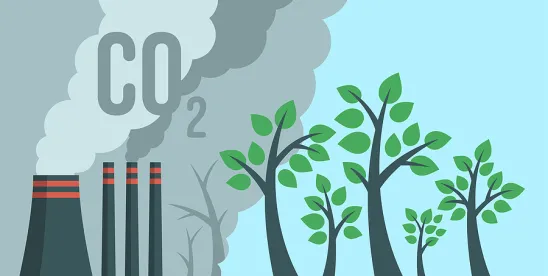Introduction
Continuing the regulatory whiplash over greenhouse gases (GHG) emissions from power plants, the United States Environmental Protection Agency (EPA) recently proposed repealing the Biden administration’s GHG power plant rules (Power Plant Rules), which were finalized only a year ago.1 The Power Plant Rules focused on four areas of pollution and sought to limit emissions from natural gas and coal energy generation and derivative sources.2 On 11 June 2025, EPA proposed repealing those rules to “ensure affordable and reliable energy supplies and drive down the costs of transportation, heating, utilities, farming, and manufacturing while boosting our national security.”3 If finalized, this repeal will significantly impact the energy sector, representing a rollback of some of the most burdensome requirements on power plants. That said, the proposal creates significant uncertainty for plant operators who have already taken steps to comply with the Power Plant Rules. This uncertainty will continue in the near term, as environmental groups have already promised to challenge the proposed repeal if it is finalized.
Repeal: Carbon Pollution Standards for New Gas and Existing Coal Power Plants
The primary focus of EPA’s proposed rulemaking is to repeal the GHG emissions standards established for fossil-fired power plants under former President Biden’s Carbon Pollution Standards (CPS) as well as the Greenhouse Gas New Source Performance Standards rule.
The Power Plant Rules required all coal-fired plants intending to operate past 2039, and all new baseload gas-fired plants, to employ the best system of emissions reduction (BSER) to control 90% of their carbon emissions based on carbon capture and sequestration (CCS).4 Electric generating units (EGUs) that ceased operations before 2039 were limited to 40% natural gas cofiring by 2030.5 EGUs that planned to cease operations before 2032 had no emission reduction obligations.6 Finally, in the prior rule, EPA considered CCS as the BSER by which to measure emissions reduction.7
The proposed rule considers two alternative approaches to repeal all GHG emissions standards for all fossil fuel-fired power plants.8 Under the first approach, “Significant Contribution Finding,” EPA would repeal the Power Plant Rules based on its finding that GHG emissions from fossil fuel-fired power plants do not contribute significantly to dangerous air pollution, and therefore are not subject to Clean Air Act (CAA) regulation.9 Under the second approach, “Carbon Pollution Standards Repeal,” EPA would repeal a narrower set of requirements of the Power Plant Rules because they fail to satisfy the requirements of CAA section 111: i.e., a repeal of (1) the emission guidelines for existing fossil fuel-fired steam generating units, (2) the CCS-based standards for coal-fired steam generating units undertaking a large modification, and (3) the CCS-based standards for new base load stationary combustion turbines.10
Significant Contribution Finding
The proposed rule notes that the last decade has been one of regulatory uncertainty due to EPA’s “novel attempts to regulate GHG emissions from fossil fuel-fired power plants under CAA section 111.”11 The Agency aims to resolve this by reinterpreting its own authority under CAA section 111.
CAA section 111 is known as the Significant Contribution Finding provision because it requires the EPA administrator to identify categories of stationary sources that, in the administrator’s judgment, “cause[], or contribute[] significantly to, air pollution” that “may reasonably be anticipated to endanger public health or welfare.”12 Whenever a new category is identified, EPA must establish performance standards for the identified source category.13
Under the proposed rulemaking, EPA would reverse its previous findings underlying the Power Plant Rules and conclude that GHG emissions from fossil fuel-fired plants do not contribute significantly to an endangerment of public health and welfare.14
This shift is premised on EPA’s proposed new reading of CAA section 111, which would interpret the statute as requiring a pollutant-specific finding that the source category is a significant contributor to harmful air pollution.15 In other words, EPA previously read CAA section 111 to be triggered for all air pollutants from a source category once the source was initially deemed a significant contributor for any pollutant. But now EPA is considering a narrower reading, where section 111 is only triggered on a pollutant-by-pollutant basis, requiring EPA to make a distinct finding that GHG emissions from fossil fuel-fired plants are a significant contributor to harmful air pollution. With Chevron deference gone, EPA is aiming to cement its new reading of CAA section 111 as the only “best” reading of the statute.16 If the courts ultimately agree, EPA’s new interpretation could well be long lasting.
The proposed rule would further broaden the “significance” aspect of the Significant Contribution Finding to include cost factors and policy factors, beyond endangerment of public health or welfare. Under this change, EPA lists a series of rationales for its proposed finding that GHG emissions from fossil fuel-fired plants do not constitute a Significant Contribution Finding, based primarily on the current administration’s priority of promoting health or welfare “through energy dominance and independence secured by using fossil fuels to generate power.”17 Under its proposed reading of the CAA, EPA would find that GHG emissions from fossil fuel-fired power plants do not contribute significantly to air pollution, because they constitute only 3% of total global GHG emissions.18 EPA thus proposes to repeal all GHG emissions standards for the power sector under CAA section 111.19
Carbon Pollution Standards Repeal
The second approach EPA is considering focuses on a narrower repeal that would eliminate specific GHG emission standards based on revised BSER determinations for the CPS in the Power Plant Rules.20 Under this approach, EPA would conclude that the determination underlying the CPS under the Power Plant Rules failed to meet the CAA section 111 requirements for a valid performance standard because it did not reflect “the degree of emission limitation achievable through the application of the” BSER that “the Administrator determines has been adequately demonstrated.”21 The proposed rules go on to list factors including unreasonable costs of compliance, unachievable deadlines to fulfill infrastructure needs, and generally that CCS has not been adequately demonstrated. Because the administrator is now considering cost and new policy factors, EPA reasons that the current requirements do not constitute a valid performance standard.
Finally, this alternative approach would not reopen the BSER determinations or performance standards for (1) new and reconstructed intermediate load and low load fossil fuel-fired stationary combustion turbines or (2) for phase 1 for new and reconstructed base load fossil fuel-fired stationary combustion turbines.22
Repeal: Mercury and Air Toxics Standards
EPA is also proposing to repeal the 2024 updates to the Mercury and Air Toxics Standards (MATS) for power plants.23 The previously issued final rule strengthened and updated the existing MATS for coal-fired power plants, tightened the emissions standard for toxic metals by 67% and finalized a 70% reduction in the emissions standard for mercury from existing lignite-fired sources.24 EPA also previously limited the nonmercury hazardous air pollutants (HAP) metals from existing coal-fired power plants by significantly reducing the emission standard for filterable particulate matter to two-thirds reduced rate, which was a surrogate emission standard to control nonmercury HAP metals.25 Finally, EPA previously required the use of continuous emission monitoring systems to provide real-time data to regulators, facility operators, and the public to ensure compliance.
EPA’s proposed repeal of the 2024 MATS rule was telegraphed in Administrator Zeldin’s 12 March 2025 announcement that EPA would undertake 31 deregulatory actions in order to “Power the Great American Comeback.”26
The proposed rule aims to dismantle: (1) the new and more stringent filterable particulate matter standards for coal-fired power plants, (2) the compliance demonstration requirement that coal-fired power plants install particulate matter continuous emissions monitoring systems, and (3) the stricter mercury standards for lignite-fired power plants.27 The EPA’s justification for repealing the 2024 MATS rule is that the standards would “impose large compliance costs or raise potential technical feasibility concerns.”28
Conclusion
The proposed repeal aligns squarely with the Trump administration’s deregulatory agenda and policy objectives and promises billions of dollars in compliance cost savings over the next 20 years.
EPA is requesting public comments on the proposal and encouraging stakeholders to engage in that process. EPA will accept comments through 7 August 2025. EPA will also hold a virtual public hearing on 8 July 2025 Regulated entities should consider submitting comments to provide industry-specific information that can assist in evaluating the repeal’s viability. This may be especially important, given that the outcome of this latest rulemaking could establish a definitive interpretation of CAA section 111—one that could bind future administrations and end the see-sawing federal policy toward power plant GHG emissions.
1 Greenhouse Gas Standards and Guidelines for Fossil Fuel-Fired Power Plants, Env’t Prot. Agency (18 June 2025). https://www.epa.gov/stationary-sources-air-pollution/greenhouse-gas-standards-and-guidelines-fossil-fuel-fired-power#:~:text=EPA%20has%20issued%20final.
2 For more information on the 2024 rulemaking, see our prior alert (https://www.klgates.com/EPA-Issues-New-Power-Plant-Rules-5-14-2024).
3 Id.
4 See e.g., New Source Performance Standards for Greenhouse Gas Emissions, 89 Fed. Reg. 39798 (9 May 2024) (to be codified at 40 C.F.R. pt. 60).
5 Id. at 39838.
6 Id.
7 Id. at 39827, 39899-39902.
8 See Repeal of Greenhouse Gas Emissions Standards for Fossil Fuel-Fired Electric Generating Units, 90 Fed. Reg. 25752 (17 June 2025) (to be codified at 40 C.F.R. pt. 60).
9 Id. at 25752.
10 Id.
11 Id. at 25754.
12 42 U.S.C. § 7411(b)(1)(A); CAA § 111(b)(1)(A).
13 See generally Kate Welty & Dena Adler, Significant by Any Measure: Reviewing Power Plant Emissions Under Section 111 of the Clean Air Act, INSTITUTE FOR POLICY INTEGRITY AT N.Y.U. SCHOOL OF LAW (27 May 2025), https://policyintegrity.org/publications/detail/significant-by-any-measure#:~:text=Section%20111%20of%20the%20Clean%20Air%20Act%20requires%20EPA%20to,an%20already%20listed%20source%20category.
14 See 90 Fed. Reg. 25755.
15 Id. at 25755-56.
16 The End of Chevron Deference: What the Supreme Court's Ruling in Loper Bright Means for the Regulated Community, K&L Gates U.S. Public Policy & Law Alert (28 June 2024), https://www.klgates.com/The-End-of-Chevron-Deference-What-the-Supreme-Courts-Ruling-in-Loper-Bright-Means-for-the-Regulated-Community-6-28-2024.
17 90 Fed. Reg. 25755.
18 Id. at 25768.
19 Id.
20 EPA’s proposal is an alternative to repealing the GHG emissions standards for new and existing sources listed in subparts TTTT, TTTTa, and UUUUb. See id.
21 Id. at 25757.
22 Id.
23 See Repeal of Amendments to National Emission Standards for Hazardous Air Pollutants: Coal- and Oil-Fired Electric Utility Steam Generating Units, 90 Fed. Reg. 25535 (17 June 2025) (to be codified at 40 C.F.R. pt. 63).
24 See National Emission Standards for Hazardous Air Pollutants, 89 Fed. Reg. 38508, 38510 (May 7, 2024) (to be codified at 40 C.F.R. pt. 63).
25 Id. at 38510.
26 See 90 Fed. Reg. 25535, 25537.
27 Id.
28 Id.








 />i
/>i

